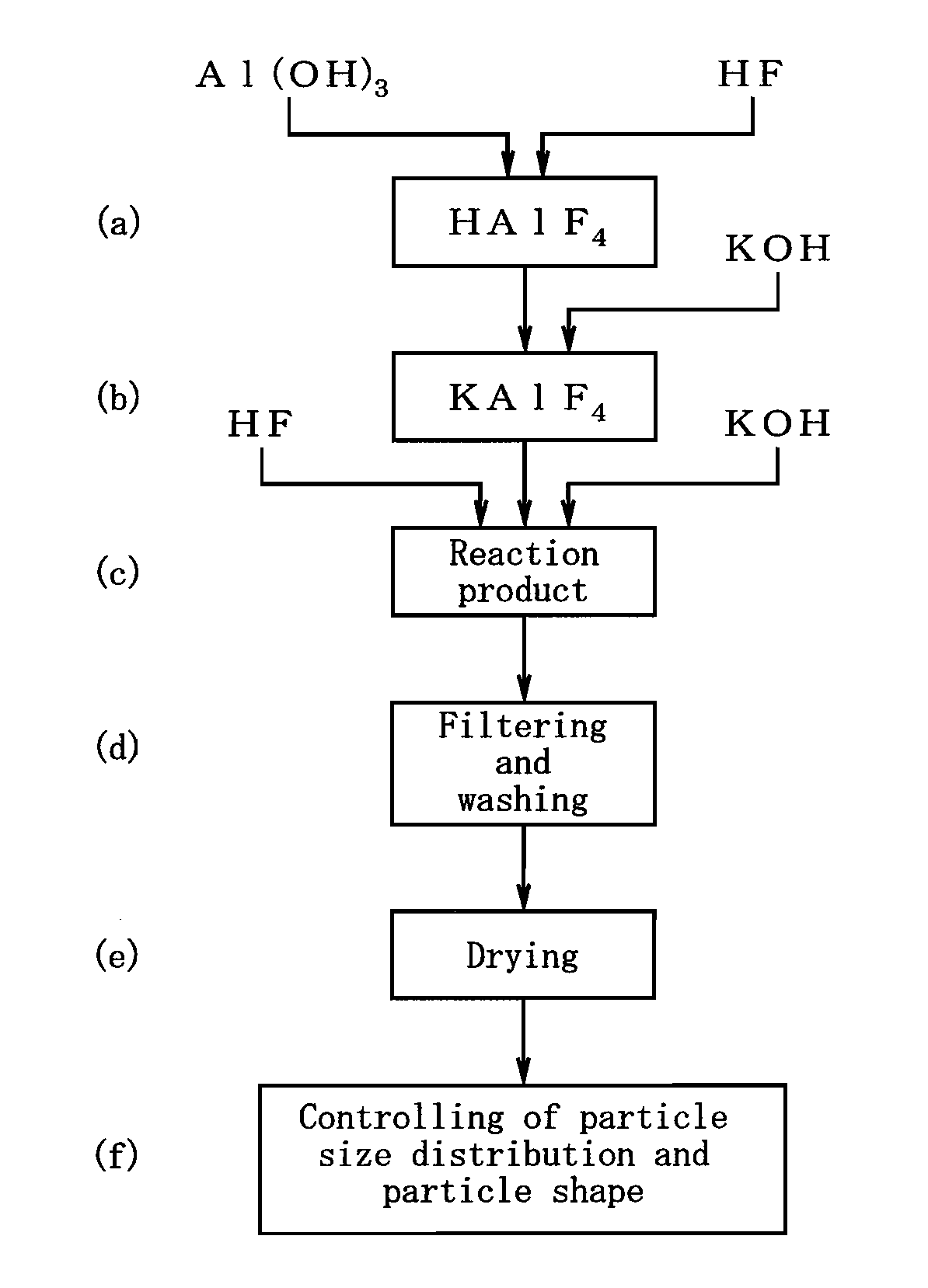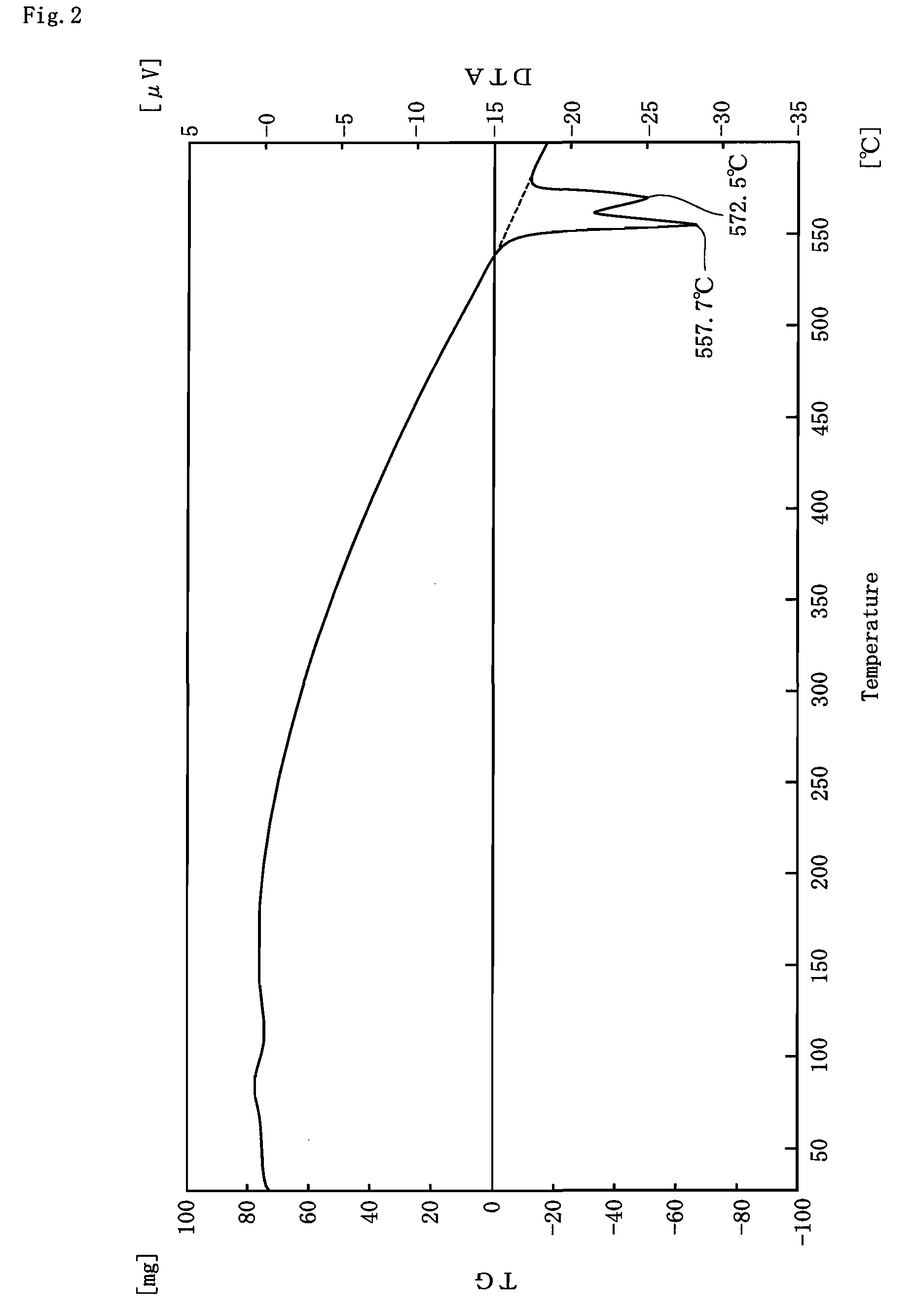Brazing flux powder for aluminum-based material and production method of flux powder
a technology of flux powder and aluminum-based materials, which is applied in the direction of manufacturing tools, welding/cutting media/materials, and manufacturing tools, etc., can solve the problems of insufficient removal of an oxide layer at the surface of the aluminum-based material, flux fails to exhibit a sufficient capacity for brazing of an aluminum-based material containing mg, and flux fails to have a sufficient spreadability, etc., to achieve the effect of improving the ability to remove an oxide layer, improving the flowability and the spread
Inactive Publication Date: 2009-02-26
MITSUBISHI MATERIALS ELECTRONICS CHEM CO LTD +1
View PDF4 Cites 10 Cited by
- Summary
- Abstract
- Description
- Claims
- Application Information
AI Technical Summary
Benefits of technology
[0029]The flux powder of the present invention includes K2AlF5·H2O restrained from sufficiently establishing a stoichiometric composition and from sufficiently growing in crystallinity such that part or the whole of the crystal structure of K2AlF5·H2O is at least one of a K-defective type, F-defective type, and K-and-F-defective type crystal structure, so that flowability and spreadability are improved upon melting to thereby improve an ability to remove an oxide layer at a surface of an aluminum-based material having an Mg content of 0.1 to 1.0 wt % upon brazing of the material as compared to the conventional flux powders, and the coating amount of the flux powder onto the Mg-containing aluminum-based material can be remarkably decreased as compared to those of the conventional flux powders, thereby enabling achievement of excellent brazing. Further, the flux powder of the present invention is non-corrosive and thus excellent in safety, relatively inexpensive and thus excellent in economical efficiency, and usable widely and generally.
[0030]Further, the flux powder production method of the present invention comprises the steps of: adopting aluminum hydroxide, hydrofluoric acid, and potassium hydroxide, as starting compounds; adjusting the starting compounds to a K / Al molar ratio within a range of 1.00 to 1.20 and an F / Al molar ratio within a range of 4.00 to 4.20; and wet reacting the starting compounds with one another at a reaction temperature of 70 to 100° C.; thereby allowing for obtainment of a flux powder where part or the whole of the crystal structure of K2AlF5·H2O is at least one of a K-defective type, F-defective type, and K-and-F-defective type crystal structure.
Problems solved by technology
However, the KF—AlF3 based flux has such a defect that the flux fails to exhibit a sufficient capability for brazing of an aluminum-based material containing Mg.
Thus, the melted flux fails to have a sufficient spreadability while KAlF4 as the main component of the flux is consumed due to the reaction, removal of an oxide layer at the surface of the aluminum-based material is not sufficiently attained.
This has resulted in a problem that the presently used fluxes each fail to obtain a sufficient spreadability such that an oxide layer at a material surface is not removed in case of brazing of an Mg-containing aluminum-based material, unless each flux is coated in an amount of about five times as much as that in case of an aluminum-based material without containing Mg.
Method used
the structure of the environmentally friendly knitted fabric provided by the present invention; figure 2 Flow chart of the yarn wrapping machine for environmentally friendly knitted fabrics and storage devices; image 3 Is the parameter map of the yarn covering machine
View moreImage
Smart Image Click on the blue labels to locate them in the text.
Smart ImageViewing Examples
Examples
Experimental program
Comparison scheme
Effect test
examples
[0059]Examples of the present invention will be described in detail, together with Comparative Examples.
the structure of the environmentally friendly knitted fabric provided by the present invention; figure 2 Flow chart of the yarn wrapping machine for environmentally friendly knitted fabrics and storage devices; image 3 Is the parameter map of the yarn covering machine
Login to View More PUM
| Property | Measurement | Unit |
|---|---|---|
| F/Al molar ratio | aaaaa | aaaaa |
| F/Al molar ratio | aaaaa | aaaaa |
| molar ratio | aaaaa | aaaaa |
Login to View More
Abstract
It is aimed at providing a brazing flux powder, which exhibits an excellent spreadability in case of brazing of an Mg-containing aluminum-based material, which is non-corrosive and is thus excellent in safety, which is relatively inexpensive and is thus economically excellent, and which can be used in a wide and general manner. There is provided an improvement in a flux powder containing therein KAlF4, K2AlF5, and K2AlF5·H2O, usable for brazing of an aluminum-based material having an Mg content of 0.1 to 1.0 wt %, and the improving characteristic configuration resides in that the flux powder has a composition where a K / Al molar ratio is within a range of 1.00 to 1.20 and an F / Al molar ratio is within a range of 3.80 to 4.10, and the K2AlF5 and K2AlF5·H2O have a sum content of 6.0 to 40.0 wt %, balance KAlF4, and that part or the whole of the crystal structure of K2AlF5·H2O is at least one of a K-defective type, F-defective type, and K-and-F-defective type crystal structure.
Description
TECHNICAL FIELD[0001]The present invention relates to a flux powder suitable for brazing of an aluminum-based material containing magnesium, and a production method of the flux powder.BACKGROUND ART[0002]For brazing of an aluminum-based material, there has been conventionally used, as a brazing filler metal, an eutectic aluminum-silicon (Al—Si) alloy having a melting point slightly lower than that of an aluminum-based material. To satisfactorily join the brazing filler metal and an aluminum-based material to each other, it is required to remove an oxide layer formed on a surface of the aluminum-based material, so that fluoride-based fluxes have been used for removal of such oxide layers. Among them, there has been most widely used an non-corrosive flux comprising a complex (potassium fluoroaluminate) based on potassium fluoride (KF) and aluminum fluoride (AlF3), because the non-corrosive flux has such various improved capabilities that: the flux can be directly coated or dispersed o...
Claims
the structure of the environmentally friendly knitted fabric provided by the present invention; figure 2 Flow chart of the yarn wrapping machine for environmentally friendly knitted fabrics and storage devices; image 3 Is the parameter map of the yarn covering machine
Login to View More Application Information
Patent Timeline
 Login to View More
Login to View More Patent Type & Authority Applications(United States)
IPC IPC(8): B23K35/22B22F9/16
CPCB23K35/3605B23K35/362B23K35/40B22F9/20
Inventor HONDA, KAZUYOSHISAITOH, SATORU
Owner MITSUBISHI MATERIALS ELECTRONICS CHEM CO LTD
Features
- R&D
- Intellectual Property
- Life Sciences
- Materials
- Tech Scout
Why Patsnap Eureka
- Unparalleled Data Quality
- Higher Quality Content
- 60% Fewer Hallucinations
Social media
Patsnap Eureka Blog
Learn More Browse by: Latest US Patents, China's latest patents, Technical Efficacy Thesaurus, Application Domain, Technology Topic, Popular Technical Reports.
© 2025 PatSnap. All rights reserved.Legal|Privacy policy|Modern Slavery Act Transparency Statement|Sitemap|About US| Contact US: help@patsnap.com



